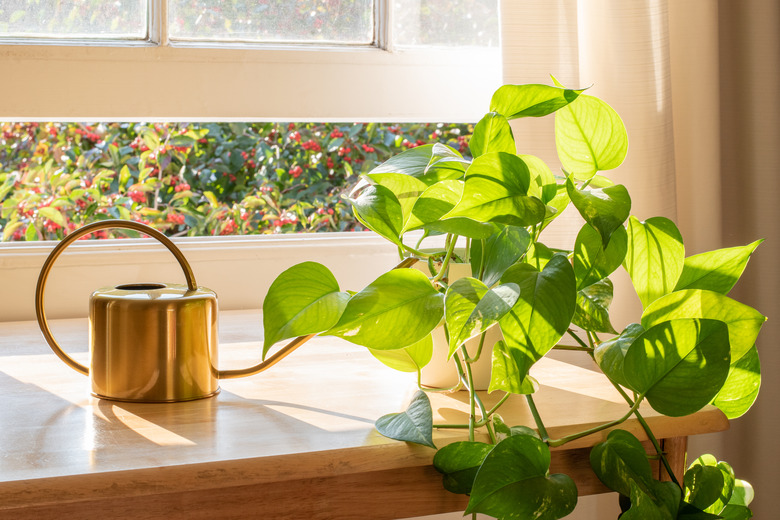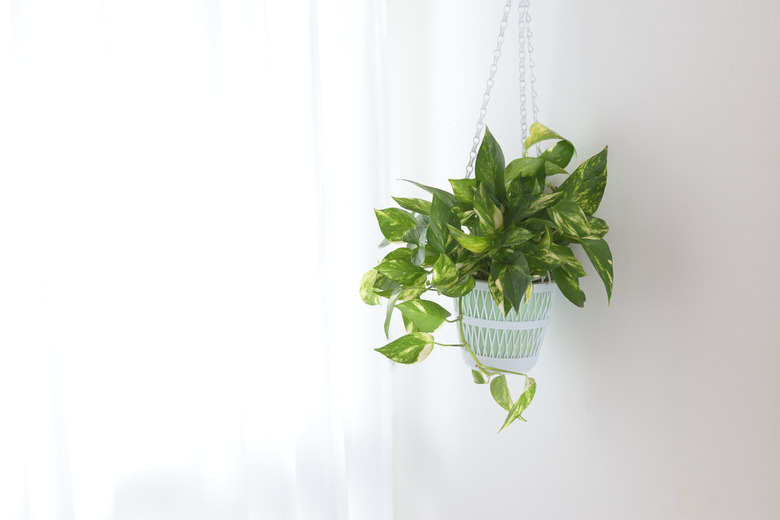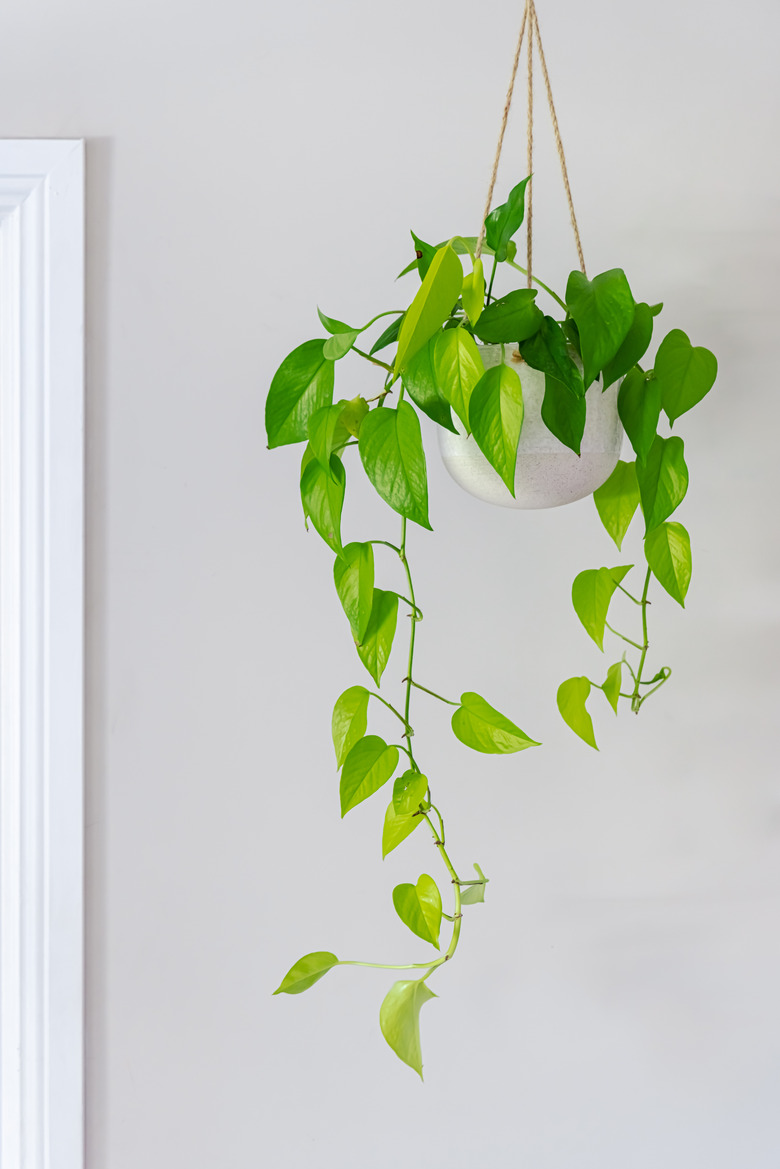How To Care For A Pothos Plant
We may receive a commission on purchases made from links.
While some houseplants are extremely finicky, others require little attention and still seem to thrive. To that last group, add the pothos plant (Epipremnum aureum) — an evergreen vine that is so tough and difficult to harm that many people know it as "devil's ivy."
Pothos is native to southeast Asia and the western Pacific, where it grows as a ground cover or a climbing vine. It can survive outdoors in USDA zones 10 and 11, but many areas list it as an invasive species. Most people know it as an easy-to-care-for houseplant that requires little attention. It can thrive at regular room temperatures as long as it receives bright, indirect light, although it is known for surviving after being deprived of light for short periods.
Many people confuse pothos with philodendron (Philodendron scandens), but they are different plants. Philodendrons have green heart-shaped leaves on slender stems. Pothos have shiny green leaves that range in size from 4 to 8 inches and have gold, white or yellow variegated markings. The plant produces small white flowers in the wild but not in the home. Popular pothos cultivars include Epipremnum aureum 'Marble Queen' and 'Neon.'
Best Uses for Pothos
Best Uses for Pothos
Pothos may be the ideal indoor plant. It is easy to care for, and it complements a number of housing styles. It has a trailing or cascading habit that makes it a natural choice for hanging planters, or it can be placed on a shelf or plant stand so that it has space to spread out.
Because it thrives at average indoor temperatures and does not require direct sunlight, it can be placed in pretty much any area of the home that receives indirect sunlight. It is often found hanging in corners to soften the edges of a room. Pothos can be grouped with other plants to create an eye-catching decorative accent. Some cultivars, such as Neon, with its bright yellow-green color, can help brighten a dark corner. It also features patterned leaves that make them distinct from your average green plant.
Although most people like the plant for its training habit, pothos can climb. In the wild, it can climb up trees and the exterior walls of buildings. As a houseplant, it can climb up posts or even walls. You should be cautioned, however, that the plant's aerial roots, which it uses to attach itself to walls, can remove paint when you pull the plant away from the wall.
How to Care for Pothos
How to Care for Pothos
- Common Name: Pothos (also known as devil's ivy, among other names)
- Botanical Name: Epipremnum aureum
- Sun Exposure: Indirect sun
- Soil Type: Loamy, well-draining soil
- Mature Size: Vines can grow 6 to 10 feet
- When It's in Trouble: Pale leaves mean the plant is getting too much sun. If there is little variegation, it is not getting enough light.
- When It's Thriving: Leaves have good color and are not dropping
Soil, Light and Water Recommendations for Pothos
Soil, Light and Water Recommendations for Pothos
Assuming you started with a healthy plant that you purchased from a reputable source, pothos is one of the easiest houseplants to keep happy. The plant likes good soil that drains well. Any potting soil for houseplants will do as long as it drains well, and the pot has holes in the bottom to aid in drainage.
Although it is somewhat counterintuitive because of the plant's watering requirements when planted in soil, pothos can be grown in water without soil. If using tap water, allow the water to sit out for about 24 hours to give the chlorine time to evaporate. You can also use bottled water. Note that water-grown plants do not grow as quickly as those planted in potting mix.
Bright, indirect light is best for pothos. The plant is able to survive in low-light conditions, but it will not grow as vigorously as when it has adequate light. The plant's leaves will provide clues if it is not receiving enough light or if it is receiving too much light. When there is too little light, the variegation is not as pronounced. The leaves turn pale when it is receiving too much sun.
Pothos does not like soggy roots, so make sure the soil drains well and the pot that holds the plant has drainage holes. Don't plan on setting up a regular watering schedule. Water the plant when the soil is dry to the touch. It can survive for long periods between waterings, but if the plant begins to droop, give it a drink and it should perk up. However, it is better not to let it get to that stage.
Fertilizer Recommendations for Pothos
Fertilizer Recommendations for Pothos
Pothos are light feeders. During the spring and summer, give them some liquid houseplant fertilizer about once a month. Some gardeners feed the plants with a half-strength dose for the first two or three feedings. In spring, the plants are just coming out of winter dormancy and don't need the full-strength feeding they will need during their vigorous growth spurt in the summer.
Taper off the feeding schedule as you get into the fall. Don't fertilize during the winter because the plants are not actively growing then. And in fact, overfertilization can turn the tips of the leaves brown.
Humidity and Temperature Recommendations for Pothos
Humidity and Temperature Recommendations for Pothos
The natural habitats for pothos are areas of high humidity, and the plant does well in a humid environment, so bathrooms and kitchens are ideal locations. It does tolerate drier air and normal indoor humidity levels. During the winter when indoor air can be very dry, mist the plant about once a week or consider installing a humidifier in the room.
Pothos likes room temperatures in the range of 60 to 80 degrees Fahrenheit. Drafts and colder temperatures can harm the plant.
How to Prune Pothos
How to Prune Pothos
If you want long vines for a hanging planter or to trail along a shelf, let the plant grow naturally. To trim its length, cut back to just above a leaf. You can do this at any time during the spring and summer when the plant is actively growing. This allows the plant to recover from the stress of pruning.
Sometimes, leaves may turn brown or yellow. This is often due to old age or waiting too long between waterings. Simply snap off these crispy leaves and their stems with your finger or they may fall off on their own. Vines that contain only a few leaves can be cut back to about 2 inches above the roots to encourage new growth.
For bushier growth, trim long vines by cutting just above a leaf. Remove any dead leaves or stems when you find them.
Potting (and Repotting) Pothos
Potting (and Repotting) Pothos
Most pothos are sold as young plants in 4- to 6-inch pots. Most are started from cuttings because pothos seeds are very rare. As a houseplant, the pothos does not produce flowers, so there are no seeds.
Eventually your plant will outgrow the starter pot in which it came. One sign that it is time to repot is a plant that seems droopy even after you have watered it. The condition often signals a root-bound plant. Check by carefully removing the plant from the pot. Crowded roots that circle the outer perimeter of the root ball means it is time to repot.
To repot, choose a new pot that has drainage holes in the bottom and is 2 inches larger than the original pot. Gently loosen the roots and place the root ball in the new container. Add fresh potting soil — and don't reuse the potting soil you had in the plant's previous pot.
How to Propagate Pothos
How to Propagate Pothos
You can propagate pothos in either water or soil. To do so, take a 4- to 6-inch cutting of a healthy runner that has two or three leaves on it. Near each leaf is a node that looks like a small bump on the stem. The roots will grow from the nodes.
For water propagation, place the cuttings in a container that contains clean water, making sure that the nodes are submerged. Water that does not contain chlorine is best for the plants. Place the glass where it will receive indirect light. Roots will develop in two to four weeks.
You can transplant water-propagated plants in soil about four weeks after the roots develop. However, this can be tricky, and the plants may not develop properly. It is best to keep the plants growing in water.
For soil propagation, place the cutting in potting soil, making sure the nodes are buried. Roots should develop in two to four weeks, and you can transplant about four weeks later.
Common Pests and Other Problems for Pothos
Common Pests and Other Problems for Pothos
Although they are hardy plants, pothos can suffer from some common plant pests, including spider mites and mealybugs. Spider mites are tiny insects that feed on the sap of the plant, curling the leaves and turning them brown. Mealybugs look like little pieces of cotton that can form on the leaves and stems of the plant.
For small infestations, remove the pests with a steady stream of water, being careful not to harm the plant. You can also use insecticidal soap on the plant. You can control the population by rubbing the leaves and stem with a cotton ball dipped in rubbing alcohol. Rinse thoroughly when finished. If large areas of the plant contain the pests, remove the plant and replace it with a new one.
Common Diseases for Pothos
Common Diseases for Pothos
Pothos can develop root rot from overwatering or being planted in soil that does not drain well. The leaves of the plant will turn yellow and curl. Stem rot can be another problem caused by soil that does not drain. Look for a fine webbing on the soil's surface near the stems. To control diseases, apply a fungicide to the plant. Be sure to choose one for houseplants and follow the directions on the label.
Toxicity Information About Pothos
Toxicity Information About Pothos
Despite its popularity, pothos is toxic, especially if ingested in large doses. All of the plant contains calcium oxalate, an irritant that can cause swelling and burning of the mouth and throat. The sap of the plant can irritate the skin as well. Keep the plant away from pets and small children.
Pothos is often one of the plants often mentioned for its ability to remove pollutants from the air. The off-gassing of pollutants from building materials, carpeting, cleaning products and the like can harm certain individuals and lead to indoor air pollution. The theory is that houseplants can remove pollutants from the air.
The idea took root based on studies at NASA in the 1980s. Those studies had flaws, and the efficiency of houseplants as air cleaners became overinflated. Some retailers and garden writers still make the claim.
Subsequent studies disproved part of the theory. Research published in the Journal of Exposure Science & Environmental Epidemiology found that plants can remove pollutants but at extremely small levels. It takes 10 plants for every square foot of space to make any difference in air quality. Unfortunately, houseplants cannot compete with electronic air cleaners, but an air cleaner cannot dress up a corner or provide an eye-catching accent.
References
- The Old Farmer's Almanac: Growing Pothos
- Gardenista: Gardening 101: Pothos
- Wisconsin Horticulture Division of Extension: Pothos, Epipremnum aureum
- Journal of Exposure Science & Environmental Epidemiology: Potted Plants Do Not Improve Indoor Air Quality: A Review and Analysis of Reported VOC Removal Efficiencies


